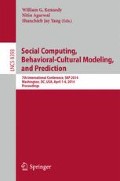Abstract
This study evaluates if social network structures in primary care teams are related to biometric outcomes of diabetic alcohol drinkers. The study results show that primary care teams with less hierarchical face-to-face social networks (i.e. more connection density, more 3-tie closures and less network centrality) have better controlled HbA1c, LDL cholesterol and blood pressure among their diabetic alcohol drinking patients. Notably, more interconnected primary care teams, with members who engage others in face-to-face communication about patient care, who feel emotionally supported by their coworkers, and who feel like they work with friends, share the same goals and objectives for patient care and have better patient outcomes, as evidenced by the diabetic biometric measures of their team’s patients.
Access this chapter
Tax calculation will be finalised at checkout
Purchases are for personal use only
Preview
Unable to display preview. Download preview PDF.
References
Mokdad, A.H., Ford, E.S., Bowman, B.A., et al.: Prevalence of obesity, diabetes, and obesity-related health risk factors. JAMA 2003 289(1), 76–79 (2001)
Hogan, P., Dall, T., Nikolov, P.: American Diabetes A. Economic costs of diabetes in the US in 2002. Diabetes Care 26(3), 917–932 (2003)
Stratton, I.M., Adler, A.I., Neil, H.A., et al.: Association of glycaemia with macrovascular and microvascular complications of type 2 diabetes (UKPDS 35): prospective observational study. BMJ (Clinical research ed) 321(7258), 405–412 (2000)
Ahmed, A.T., Karter, A.J., Warton, E.M., Doan, J.U., Weisner, C.M.: The relationship between alcohol consumption and glycemic control among patients with diabetes: the Kaiser Permanente Northern California Diabetes Registry. J. Gen. Intern. Med. 23(3), 275–282 (2008)
Chew, L.D., Nelson, K.M., Young, B.A., Bradley, K.A.: Association between alcohol consumption and diabetes preventive practices. Fam. Med. 37(8), 589–594 (2005)
Ahmed, A.T., Karter, A.J., Liu, J.: Alcohol consumption is inversely associated with adherence to diabetes self-care behaviours. Diabetic Med. 23(7), 795–802 (2006)
Engler, P.A., Ramsey, S.E., Smith, R.J.: Alcohol use of diabetes patients: the need for assessment and intervention. Acta Diabetol. 50(2), 93–99 (2013)
Cox, W.M., Blount, J.P., Crowe, P.A., Singh, S.P.: Diabetic patients’ alcohol use and quality of life: relationships with prescribed treatment compliance among older males. Alcohol Clin. Exp. Res. 20(2), 327–331 (1996)
Johnson, K.H., Bazargan, M., Bing, E.G.: Alcohol consumption and compliance among inner-city minority patients with type 2 diabetes mellitus. Arch. Fam. Med. 9(10), 964–970 (2000)
Fleming, M., Brown, R., Brown, D.: The efficacy of a brief alcohol intervention combined with %CDT feedback in patients being treated for type 2 diabetes and/or hypertension. J. Stud. Alcohol 65(5), 631–637 (2004)
Ettner, S.L.: The relationship between continuity of care and the health behaviors of patients: does having a usual physician make a difference? Med. Care. 37(6), 547–555 (1999)
Cook, W.K., Cherpitel, C.J.: Access to health care and heavy drinking in patients with diabetes or hypertension: implications for alcohol interventions. Subst. Use Misuse 47(6), 726–733 (2012)
Dijkstra, R., Braspenning, J., Grol, R.: Implementing diabetes passports to focus practice reorganization on improving diabetes care. Int. J. Qual. Health C 20(1), 72–77 (2008)
Stevenson, K., Baker, R., Farooqi, A., Sorrie, R., Khunti, K.: Features of primary health care teams associated with successful quality improvement of diabetes care: a qualitative study. Fam. Pract. 18(1), 21–26 (2001)
Mohr, D.C., Benzer, J.K., Young, G.J.: Provider Workload and Quality of Care in Primary Care Settings Moderating Role of Relational Climate. Med. Care 51(1), 108–114 (2013)
Sparrowe, R.T., Liden, R.C., Wayne, S.J., Kraimer, M.L.: Social networks and the performance of individuals and groups. Acad. Manage. J. 44(2), 316–325 (2001)
Balkundi, P., Harrison, D.A.: Ties, leaders, and time in teams: Strong inference about network structure’s effects on team viability and performance. Acad. Manage. J. 49(1), 49–68 (2006)
Chambers, D., Wilson, P., Thompson, C., Harden, M.: Social Network Analysis in Healthcare Settings: A Systematic Scoping Review. PLoS One 7(8) (2012)
Schmutz, J., Manser, T.: Do team processes really have an effect on clinical performance? A systematic literature review. Br. J. Anaesth. 110(4), 529–544 (2013)
Davidoff, F.: Heterogeneity Is Not Always Noise Lessons From Improvement. JAMA 302(23), 2580–2586 (2009)
Zhou, S.H., Siu, F., Wang, M.H.: Effects of social tie content on knowledge transfer. J. Knowl. Manag. 14(3), 449–463 (2010)
Lin, C.P.: To share or not to share: Modeling tacit knowledge sharing, its mediators and antecedents. J. Bus. Ethics 70(4), 411–428 (2007)
Zhong, X.P., Huang, Q., Davison, R.M., Yang, X., Chen, H.P.: Empowering teams through social network ties. Int. J. Inform. Manage. 32(3), 209–220 (2012)
Lee, D., Pae, J., Wong, Y.: A model of close business relationships in China (guanxi). Eur. J. Marketing 35(1/2), 51–69 (2001)
Ibarra, H., Andrews, S.B.: Power, Social-Influence, and Sense Making - Effects of Network Centrality and Proximity on Employee Perceptions. Adm. Sci. Q. 38(2), 277–303 (1993)
Berman, E.M., West, J.P., Richter, M.N.: Workplace relations: Friendship patterns and consequences (according to managers). Public Adm. Rev. 62(2), 217–230 (2002)
Gibbons, D.E.: Friendship and advice networks in the context of changing professional values. Adm. Sci. Q. 49(2), 238–262 (2004)
Anderson, N.R., West, M.A.: Measuring climate for work group innovation: development and validation of the team climate inventory. J. Organ. Behav. 19(3), 235–254 (1998)
Author information
Authors and Affiliations
Editor information
Editors and Affiliations
Rights and permissions
Copyright information
© 2014 Springer International Publishing Switzerland
About this paper
Cite this paper
Mundt, M.P., Zakletskaia, L.I. (2014). Social Network Structures of Primary Health Care Teams Associated with Health Outcomes in Alcohol Drinkers with Diabetes. In: Kennedy, W.G., Agarwal, N., Yang, S.J. (eds) Social Computing, Behavioral-Cultural Modeling and Prediction. SBP 2014. Lecture Notes in Computer Science, vol 8393. Springer, Cham. https://doi.org/10.1007/978-3-319-05579-4_40
Download citation
DOI: https://doi.org/10.1007/978-3-319-05579-4_40
Publisher Name: Springer, Cham
Print ISBN: 978-3-319-05578-7
Online ISBN: 978-3-319-05579-4
eBook Packages: Computer ScienceComputer Science (R0)

